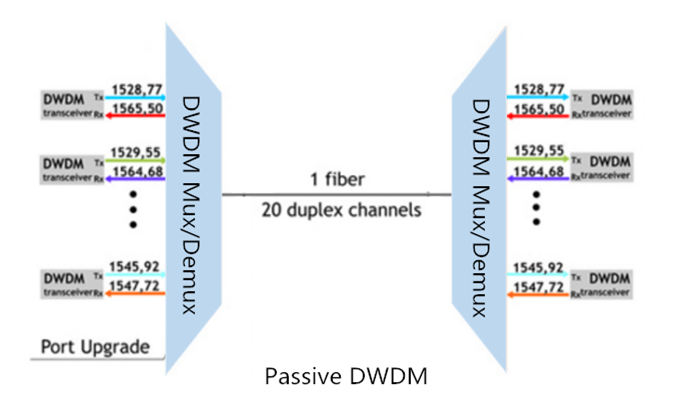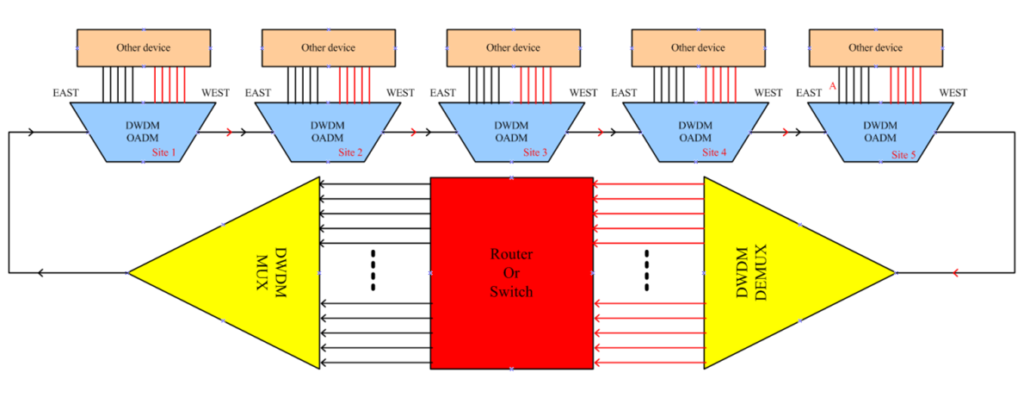DWDM technology has been regarded as an ideal solution for long haul optical transmissions. Usually the common passive system is CWDM but not DWDM. However, passive DWDM network also can offer perfect performance in some cases. This post focuses on the process of building a passive DWDM network, which includes the selection of related products, loss calculation and other factors needed to consider.
In general, “passive” in DWDM optical networks means there are no powered parts inside, which is opposed to an active system that has a powered element like EDFA (erbium doped amplifier). In a passive DWDM network, the line functions only due to the use of optical transceiver. Passive DWDM systems have a high channel capacity and potential for expansion. The drawback is that passive DWDM networks only suit long runs applications.

Passive systems have the same wavelength channel capacity as active systems. Though passive DWDM network has a limited transmission distance, it is more cost-saving and simpler compared with active DWDM systems. Because it doesn’t need active components like optical amplifiers or OEO transponder. And passive DWDM network is easy to control due to its physical cabling that the wavelength is tied to the optic.
Building a passive WDM network, no matter passive CWDM or DWDM network, is not an easy task. There are many factors that need to be taken into consideration. Now in the following part, I will give an example of a client to illustrate how to build a passive DWDM network.
Situation: there are four optical rings DWDM links using single mode fiber cable. The distance of each ring is 10km. And each ring has up to 21 outdoor cabinets.
Requirements: all equipment should be passive (no power/cooling required); all outdoor cabinets will serve business customers with direct fiber cable. (PON splitters 1:8 at least); the ring should be designed with redundancy standards. And the goal is to serve our customers with high quality protected data services via fiber optic cables.
Here is a simple graph showing the passive DWDM network structure (cabinets have been omitted in this graph).
Selection of products. According to the requirement of the customer, these products are needed in the connection.
| Product | Description |
| DWDM MUX/ DEMUX | 32 Channels Single Fiber DWDM MUX/ DEMUX |
| DWDM OADM | Single Fiber DWDM OADM, Splice Pigtailed ABS Module |
| DWDM SFP | 1000BASE-DWDM SFP 100GHz 120km DOM Transceiver |
| Fiber optic patch cord | 10m Duplex Fiber Optic Patch Cord |
Loss calculation. Each connector introduces loss in optical connections. Considering the changes of some components, the loss calculation is a little different from the one I mentioned in the article How to Calculate DWDM System Loss in Long Haul Transmission, which just shows the calculation of part connections in a link. In this connection, the total loss=fiber optic mux loss+ fiber loss+connectors loss+ OADM loss. According to the components used, the total loss is 32dB.
Deployment. After determining the products and power budget of the whole links, the next step is to deploy all components in the links. And learning some tips like avoiding end face contamination, or not bending fiber cables, will be helpful.
This post just gives a simple illustration to build a passive DWDM network. In fact, in actual DWDM network, there are various factors to consider. For instance, transmission distance, data rate, power budget, selection of optical components, etc. And even in final deployment, other problems may also arise. Therefore, quality products and professional team are important when designing passive DWDM networks. FS.COM, as a professional optical components and solutions supplier, can provide you reliable support for your DWDM networks. Welcome to visit FS.COM for more detailed information.





